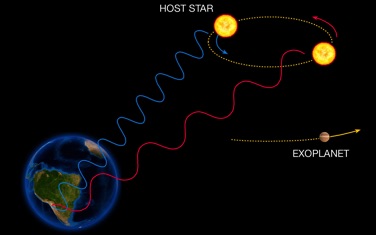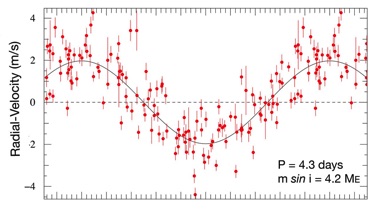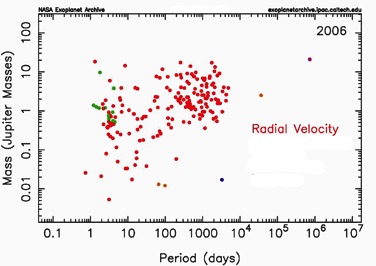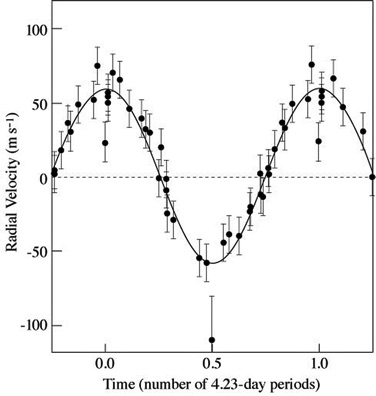By their very definition, exoplanets are difficult to detect. They are both smaller and much dimmer than their parent stars. Great precision and accuracy in measurements is required in order to determine the presence of an exoplanet.
The method that lead to the initial detection of a substantial number of exoplanets is known as the radial velocity method. This method depends on the slight wobbling of a star as a large exoplanet circles around it. For example, examine the star known as HIP27887 in the main view panel. Assume that this star has an exoplanet circling it (labeled HIP27887 b). If this exoplanet initially lies between the observer (i.e. you) and its star, then the gravitational attraction from the exoplanet would pull the star slightly in your direction. This would result in the light from the star being slightly blue shifted as a result of a Doppler shift in the light. When the exoplanet is on the far side of its star, the exoplanet’s gravitational attraction would then pull the star slightly away from you. You would then observe this as a slight red shift in the star’s emitted light. The motion of the exoplanet around its star would thus result in a regular pattern of emitted light from the parent star changing from a blue shift to a red shift, and then back again to a blue shift. It is this periodic shifting of light between blue and red from a particular star that alerts scientists to the presence of a possible exoplanet. The exoplanet is not directly observed, but its presence is inferred from the periodic light pattern of its host star.
This technique will only work if the star exhibits a regular and periodic Doppler shift in its emitted light. This means that the orbiting exoplanet must be large enough that it has enough gravitational attraction to influence the parent star. The radial velocity method works best on large exoplanets that are orbiting close to their parent stars.
The exoplanet in the main view panel, HIP27887 b, was discovered in 2008 by the radial velocity method.
(Note: Subsequent measurements have shown that HIP27887 actually has six exoplanets in its solar system. Click here to see the entire solar system for this star.)
A Very Special Exoplanet
In 1995, an exoplanet was discovered orbiting the star 51 Pegasi. This exoplanet, named 51 Pegasi b, was discovered using the radial velocity method. The discovery of 51 Pegasi b is important because it was the first exoplanet found to be orbiting a main-sequence star. Indeed, 51 Pegasi is a star that actually bears many similarities to our own Sun. 51 Pegasi is a G2V class spectral type star (as is the Sun), it has a mass 1.06 times that of our Sun, and a radius that is 1.2 times that of the Sun. The exoplanet 51 Pegasi b, however, is quite unlike Earth in its physical properties. It has an orbital period of 4.23 Earth days, a mass that is approximately 150 times that of Earth, and a surface temperature of approximately 5,000° C (9,000° F).



